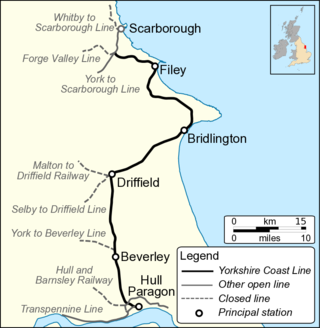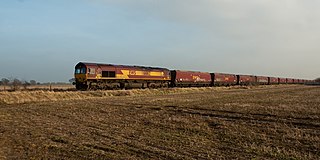Related Research Articles

The London, Midland and Scottish Railway (LMS) was a British railway company. It was formed on 1 January 1923 under the Railways Act 1921, which required the grouping of over 120 separate railways into four. The companies merged into the LMS included the London and North Western Railway, the Midland Railway, the Lancashire and Yorkshire Railway, several Scottish railway companies, and numerous other, smaller ventures.

The London and North Eastern Railway (LNER) was the second largest of the "Big Four" railway companies created by the Railways Act 1921 in Britain. It operated from 1 January 1923 until nationalisation on 1 January 1948. At that time, it was divided into the new British Railways' Eastern Region, North Eastern Region, and partially the Scottish Region.

The East Coast Main Line (ECML) is a 393-mile long (632 km) electrified railway between its northern terminus at Edinburgh Waverley and southern terminus at London King's Cross. The key towns and cities of Peterborough, Doncaster, York, Darlington, Durham and Newcastle are on the line. The line is a key transport artery on the eastern side of Great Britain running broadly parallel to the A1 road. The main line acts as a 'spine' for several diverging branches, serving destinations such as Cambridge, Leeds, Hull, Sunderland and Lincoln, all with direct services to London. In addition, a few ECML services extend beyond Edinburgh to serve other Scottish destinations, such as Stirling, Inverness, Dundee, or Aberdeen.

Gidea Park railway station is on the Great Eastern Main Line, serving the neighbourhood of Gidea Park in Romford, located in the London Borough of Havering, east London. It is 13 miles 41 chains (21.7 km) down the line from London Liverpool Street and is situated between Romford and Harold Wood. Its three-letter station code is GDP and it is in Travelcard zone 6. The station is managed and served by the Elizabeth line.

York railway station is a principal stop on the East Coast Main Line (ECML) serving the cathedral city of York, North Yorkshire, England. It is 188 miles 40 chains (303.4 km) north of London King's Cross and, on the main line, it is situated between Doncaster to the south and Thirsk to the north. As of June 2018, the station is operated by London North Eastern Railway (LNER). It is the busiest station in North Yorkshire, the third busiest in Yorkshire & the Humber and the sixth busiest in Northern England, as well as being the busiest intermediate station on the East Coast Main Line. In Britain's 100 Best Railway Stations by Simon Jenkins, the station was one of only ten to be awarded five stars.

The Harrow and Wealdstone rail crash was a three-train collision at Harrow and Wealdstone station in Wealdstone, Middlesex during the morning rush hour of 8 October 1952. The crash resulted in 112 deaths and 340 injuries, 88 of these being detained in hospital. It remains the worst peacetime rail crash in British history and the second deadliest overall after the Quintinshill rail disaster of 1915.

Hull Paragon Interchange is a transport interchange providing rail, bus and coach services located in the city centre of Kingston upon Hull, England. The G. T. Andrews-designed station was originally named Paragon Station, and together with the adjoining Station Hotel, it opened in 1847 as the new Hull terminus for the growing traffic of the York and North Midland (Y&NMR) leased to the Hull and Selby Railway (H&S). As well as trains to the west, the station was the terminus of the Y&NMR and H&S railway's Hull to Scarborough Line. From the 1860s the station also became the terminus of the Hull and Holderness and Hull and Hornsea railways.

Thirsk railway station is on the East Coast Main Line and serves the market town of Thirsk, North Yorkshire, England. It is situated between York to the south and Northallerton to the north. Its three-letter station code is THI. The station is about 2 miles (3 km) outside of Thirsk town centre and is actually on the edge of the village of Carlton Miniott.

The Hull–Scarborough line, also known as the Yorkshire Coast Line, is a railway line in Yorkshire, England that is used primarily for passenger traffic. It runs northwards from Hull Paragon via Beverley and Driffield to Bridlington, joining the York–Scarborough line at a junction near Seamer before terminating at Scarborough railway station.

Over the latter years of the 19th and early years of the 20th centuries, Penistone in Yorkshire gained a name as an accident black-spot on Britain's railway network; indeed, it could be said to hold the title of the worst accident black-spot in the country. The main line through the town was the Woodhead route of the Manchester, Sheffield and Lincolnshire Railway between Sheffield Victoria and Manchester, London Road. The line was heavily graded with a summit some 400 yards inside the eastern portal of the Woodhead tunnel.
The Winwick rail crash took place at Winwick Junction, near Warrington on the London, Midland and Scottish Railway, on 28 September 1934. Two trains collided, resulting in 11 deaths and 19 injured.

Spean Bridge railway station is a railway station serving the village of Spean Bridge in the Highland region of Scotland. This station is on the West Highland Line, between Roy Bridge and Fort William, sited 90 miles 56 chains (146 km) from Craigendoran Junction, near Helensburgh. ScotRail manage the station and operate most services, along with Caledonian Sleeper.

On the evening of 4 December 1957, two trains crashed in dense fog on the South Eastern Main Line near Lewisham in south-east London, causing the deaths of 90 people and injuring 173. An electric train to Hayes had stopped at a signal under a rail bridge, and the following steam train to Ramsgate crashed into it, destroying a carriage and causing the bridge to collapse onto the steam train. The bridge had to be completely removed; it was over a week before the lines under the bridge were reopened, and another month before the bridge was rebuilt and traffic allowed over it.
Two rail accidents have occurred near Castlecary, Scotland. One of these was in 1937 and one in 1968. Both events involved rear-end collisions, and caused the deaths of 35 and 2 people respectively.

The Askern branch line is a railway line which runs in North, South and West Yorkshire in England. The stretch of track runs from Shaftholme Junction north of Doncaster, via Askern, Norton and Womersley to Knottingley, where it joins the Pontefract Line.

Doncaster PSB is a signalling centre on the East Coast Main Line (ECML) railway in the United Kingdom, principally covering the line from London to Edinburgh but also encompassing other lines diverging and converging to the ECML.
The Doncaster rail crash was a railway accident that took place near to Doncaster, England.
The King's Cross railway accident occurred on 4 February 1945, at London King's Cross railway station on the East Coast Main Line of the London & North Eastern Railway. Two passengers were killed and 25 injured, as well as the train attendant.

The 1944 Ilford rail crash occurred on 16 January 1944 when, in darkness and dense fog, an express passenger train passed a signal at danger and collided with another passenger train that was stopped at Ilford railway station in Essex, England.
References
- ↑ Mount & Langley 1947, p. 3.
- ↑ Aiton Kay, John, ed. (July 1948). "Bridge Junction accident, LNER". The Railway Magazine. Vol. 94, no. 576. London: The Railway Publishing Company. p. 272. ISSN 0033-8923.
- ↑ Mount & Langley 1947, p. 4.
- 1 2 Burke, Darren (16 March 2016). "ON THIS DAY: 14 dead, 12 injured in Doncaster train crash horror". Doncaster Free Press. Retrieved 22 April 2017.
- 1 2 Hall, Stanley (1997). "2 - East Coast Main Line". Railway accidents (1 ed.). Shepperton: Ian Allan. pp. 72–73. ISBN 0-7110-2549-5.
- 1 2 Mount & Langley 1947, p. 8.
- ↑ "1947 Rail Disaster". Doncaster History. 26 May 2011. Retrieved 22 April 2017.
- ↑ Mount & Langley 1947, p. 7.
- ↑ Mount & Langley 1947, p. 6.
Sources
- Mount, A H L; Langley, C A (6 December 1947). Report on the collision which occurred on the 9th August, 1947, near Doncaster on the London & North Eastern Railway (PDF) (Report). Ministry of Transport.